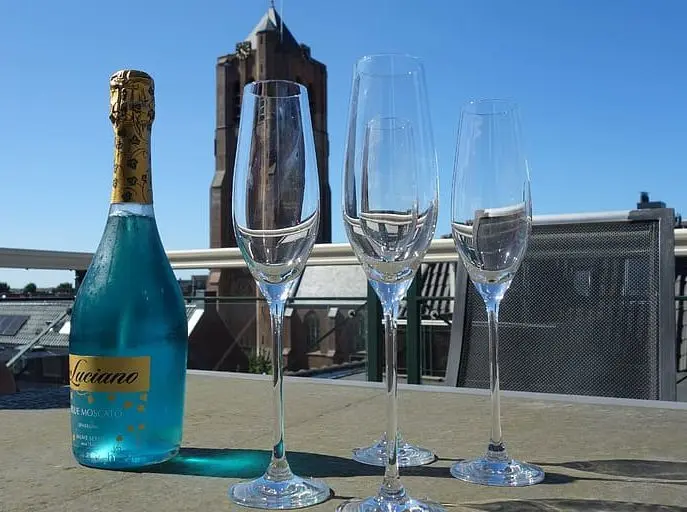Blue champagne appeared on the market relatively recently. Fashion for bright drinks with mother-of-pearl tints has spread in Europe thanks to Spanish wine brands, the most popular of which is Aviva. The high demand for multi-colored sparkling wine led to the fact that they began to produce it in many countries, including Russia. Next, we will figure out how blue champagne differs from ordinary champagne and how safe it is.
How blue champagne is made
Blue sparkling wine appeared on the market in 2015 and immediately became a hit with youth parties in Spain and France. The novelty was greeted with enthusiasm in Southeast Asia – in the countries of this region, the Spanish brand Aviva broke sales records. Colored champagnes were treated with great skepticism in the conservative United States, but soon their own manufacturers appeared there, and now blue champagne with or without sparkles no longer surprises anyone. The peak of the popularity of colored drinks in Russia has already passed – most often, such products are bought out of curiosity or to surprise guests.
The quality of the product depends on two factors: the wine material and the technology used by the manufacturer. You should not wait for the perfect flavor bouquet of sparkling wine of a weak strength of the economy segment. Most likely, the bottle will contain highly diluted carbonated wine material, for the taste of which sugar and flavors are responsible. More expensive Italian wines can be made using the usual technology for Spumante – on the market you can find colored Prosecco and Moscato from classic grape varieties. Quality brands of sparkling pale blue are produced in Spain and the USA.

The color of the drink is given with the help of food coloring. The type of additive depends on the choice of the manufacturer – the wine can be tinted with blueberry extract or anthocyanin extracted from the skin of blue grapes. Sometimes indigo is used in production, which is extracted from the Isatis tinctoria plant. Russian producers, as a rule, do not provide details about the dye in advertising, but in general, blue wine is safe for health. Under the existing enterprise certification system, processes at factories are strictly controlled, and products are quality tested in laboratories.
Kandurin is responsible for the beautiful silver overflows in champagne, which, if desired, can be found in any baking supplies store. The additive is a powder of small particles of titanium dioxide, iron oxide and mica. Despite such a threatening composition, kandurin is recognized as safe for health and is often used to decorate confectionery.
If desired, the powder can be added to any drink – juice or lemonade – to get a pearlescent effect. The additive is valued for the fact that it does not change the color and taste of the original product, only gives it a shine. When storing wine with Kandurin in a calm state for a long time, the dye settles at the bottom of the bottle, so it is recommended to shake the container before use so that the drink shines.

Famous brands of blue champagne
Blue sparkling wine usually has a sweet, fruity flavor unless the manufacturer has added a flavor with a specific flavor. In Russia, this kind of product cannot be sold as champagne, so it is labeled as a wine drink.
European producers have repeatedly reported that they use only natural dyes based on plant components in the production of their wines, and sweeteners are added instead of sugar.
Among pearlescent cocktails, Avivo still occupies the first place in the popularity rating in Russia, however, transparent blue wines are also in demand:
- Don Luciano Blue Moscato, 13% – champagne made by the continuous method of the Spanish winery Jaume Serra with hints of melon, watermelon and rose petals;
- Blanc de Bleu Cuvee Mousseux, 11% – blue brut from the Californian company Premium Vintage Cellars. As a dye, the manufacturer uses blueberries, which play the first violin to taste. Berry tones are complemented by nuances of fresh apples and lemon;
- Mix Party Bubbles Blue, 13% – sparkling with tropical fruit flavor produced by Mix Party in Texas. The highlight of blue wine is particles of edible gold in the composition;
- Platino Blue Moscato, 7% – light refreshing wine from Spain with a bright fruity taste.
Safety measures
Manufacturers assure the plant origin of their dyes, but some researchers have questions about the blue color. Experts studied the coloring ingredients of Spain’s Gïk Blue, the world’s first still wine with a bright ultramarine color, to find out how safe it is.
The company claimed that it uses natural anthocyanin and indigotin to achieve the effect, however, synthetic food coloring E133 was found in the wine, which is responsible for the bright color of Blue Curacao liqueurs. The European Union has banned the company from labeling products as wine, although the drink is made according to the classic technology from Chardonnay grapes.
However, this did not affect the popularity of the brand – E133 is successfully used in the food industry and is recognized as relatively safe. However, dyes in this category can cause an allergic reaction, so care should be taken in the case of blue champagne. You should not trust the manufacturer’s information and if you are prone to allergies, you should first try the product to make sure it is safe for health.









